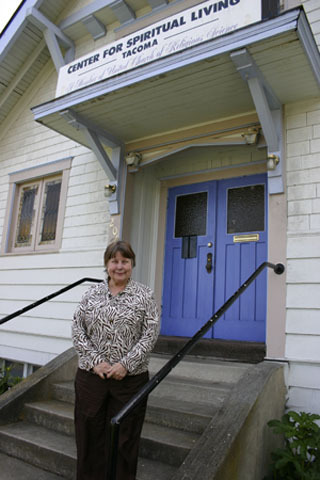EDITOR’S NOTE: The Tacoma Daily Index continues its look back at some of the significant people, stories, and photographs featured in these pages in 2008. On Dec. 22, we looked at the city’s historic preservationists. On Dec. 24, we looked at milestone moments. Today, we focus on three important buildings added to the City of Tacoma’s register of historic places. The four-part series continues through Dec. 30.
– – – – – – – – – – – – – –
1. Murray Morgan Church
To the casual observer, the Center for Spiritual Living’s church is just a small, single-story Craftsman-style building at the corner of North J Street and Division Avenue. But its age and connection to an iconic figure of Pacific Northwest was enough this year to put it on the City of Tacoma’s register of historic places.
For 99 years, the beige house with light blue trim has served several congregations of varying denominations. Today, it is home to the 150-member Center for Spiritual Living.
But one former churchgoer is of particular interest to local historians.
According to information gathered by Rev. Frances Lorenz, the Center for Spiritual Living’s minister, the late Murray Morgan — author of several books of Pacific Northwest history and a prominent Tacoma native whose namesake bridge crosses Thea Foss Waterway — was a regular parishioner. Morgan’s father, Henry, was a minister at the church for 40 years. And Murray Morgan’s wife, Rosa, taught Sunday school there.
“I think the motivation [for us to put it on the register] is that we regard the historic significance of this building,” Rev. Lorenz told the Index in May. According to the nomination application, the church’s story begins in the early-1890s, on a site blocks away. In 1892, Charles B. Wright donated a parcel of land at what is today North I Street and Division Avenue, as well as $450 toward construction of a church, to Tacoma’s Universalist congregation. The Universalists built their church, which opened in 1894 and was led by Rev. E. J. Feit. Three years later, Rev. Feit stepped down, which opened the door for Rev. Abbie Ellsworth Danforth, Tacoma’s first female pastor, in 1903.
But the Universalists soon outgrew their building.
In 1904, two developers wanted to purchase the church’s land in order to build a new grocery store. The sale allowed the congregation to purchase the site where the church sits today.
The move also brought a new minister, Rev. William D. Buchanan, who went to school with the poet Carl Sandburg, and used to bring Sandburg to Tacoma.
Rev. Buchanan had grand plans for their new place of worship: seating for 400 people, a towering steeple, and construction costs totalling $10,000. One newspaper called the design “a model of modern architecture.” The church, however, scaled back its plan. In the end, it hired architects Arnott Woodroofe and Arnold S. Constable, and contractor C. H. Hallen, to design and construct a scaled-down version of the building at half the original cost.
In 1911, Rev. Buchanan left Tacoma, which opened the door for Henry Morgan. Morgan ministered at the church between 1912 and 1952. During that time, the church changed its denomination to the Divine Science, and was renamed the Church of the Healing Christ.
Murray Morgan married his wife Rosa in 1939 in the church.
This summer, the City of Tacoma added the building to its historic register.
In 2008, the Index published the following stories about the Center for Spiritual Living’s historic church:
— Public hearing June 25 for Murray Morgan church nomination (06/20/08) http://tacomadailyindex.com/portals-code/list.cgi?paper=88&cat=23&id=1246561&more=0
— A Holy Home of History: An interview with Rev. Frances Lorenz (05/16/08) http://tacomadailyindex.com/portals-code/list.cgi?paper=88&cat=23&id=1218942&more=0
— Murray Morgan link could put North End church on city’s historic register (05/15/08) http://tacomadailyindex.com/portals-code/list.cgi?paper=88&cat=23&id=1218396&more=0
2. Frisko Freeze
The burgers are tasty. The fries are warm. The milk shakes are delicious.
But is 58-year-old Frisko Freeze worthy of historic landmark designation?
Yes, according to the City of Tacoma’s landmarks commission and city councilmembers.
“The building is a Tacoma icon,” North Slope Historic District board president Marshall McClintock told the Index in April. The idea to nominate the burger stand and its signature neon sign, located at 1201 N. Division Ave., traces back to a letter McClintock wrote last month to Frisko Freeze owner Penny Jensen.
“Marshall asked if I ever considered [putting the building on the register], which I had, but I knew it was quite a process,” said Jensen, who inherited the business when her father, Perry Smith, passed in 1990. “Owning a little business, it seems like I’m always buried in paperwork. When he contacted me and offered to do the work, I jumped at it.”
McClintock worked on the nomination application on a part-time basis. He scoured records in the Northwest Room of the Tacoma Public Library and collected stories from long-time residents who remember eating at Frisko Freeze in its early days.
According to newspaper archives, Frisko Freeze was opened July 27, 1950, by Perry Smith. Smith told a reporter at the time that the name’s inspiration came from Seattle Rainiers broadcaster Leo Lassen, who was calling a game between Seattle and ‘Frisco.’ “So I decided to call my place Frisco Freeze,” said Smith, “but I changed the spelling.”
“Frisko Freeze represents a type of architecture we don’t have on the register at all,” said Reuben McKnight, the city’s historic preservation officer. “The closest thing is probably Bob’s Java Jive, which is a whole generation earlier. It’s a nostalgic landmark that everybody in Tacoma knows. Generations of high school students have been there. It also figures into the modern American period for architecture, and we haven’t really been there for the city in terms of landmarks preservation.”
Currently, there are approximately 140 properties on the city’s historic register.
For McClintock, the experience of documenting Frisko Freeze’s history gave him a deeper understanding of the its cultural significance. “One of the things I discovered was that walk-up food stands are different from the drive-ins,” he said. “There were plenty of ice cream parlors, but they were designed on the model of sit-down restaurants. Walk-ups like Frisko Freeze kind of provided teenagers and young adults with ultimate freedom. There was little supervision, and far greater freedom than other venues. You got your food and went back to your car. That was one of the reasons they were so popular — no one was telling you how to behave. That’s the interesting sort of thing that you want to document, to be able to explain why it is that Frisko Freeze is the icon it is.”
In 2008, the Index, which was the first to report on the nomination, published the following stories about the landmark:
— Tacoma’s landmarks commission recommends adding Frisko Freeze to historic register (07/25/08) http://tacomadailyindex.com/portals-code/list.cgi?paper=88&cat=23&id=1271575&more=0
— Landmarks Commission will decide Frisko Freeze nomination today (07/23/08) http://tacomadailyindex.com/portals-code/list.cgi?paper=88&cat=23&id=1268586&more=0
— Public hearing planned for Frisko Freeze historic register nomination (06/26/08) http://tacomadailyindex.com/portals-code/list.cgi?paper=88&cat=23&id=1250797&more=0
— Murray Morgan link could put North End church on city’s historic register (05/15/08) http://tacomadailyindex.com/portals-code/list.cgi?paper=88&cat=23&id=1218396&more=0
3. Ansonia Apartments
On Sept. 30, Tacoma City Council added the 1914 Ansonia Building — a five-story building located at 215 N. Tacoma Ave. and within the National Historic Register’s Stadium Seminary Historic District — to the city’s register of historic places.
According to the historian who prepared the nomination, the Ansonia was designed by Tacoma architects Frederick Heath and George Gove as a luxury building aimed at Tacoma’s emergent upper class. Original advertisement brochures for the gilded building appealed to this demographic: each unit included wall safes for silver and jewelry; kitchens were fitted with dumb waiters and telephones connected to servants’ quarters in the basement; and roof gardens for top-floor tenants offered water views.
When the building was completed, Heath wrote of his desire for the building to “afford all the advantages of a luxurious private residence, and to restrict its occupancy to desirable tenants of known character and standing.”
Between 1914 and 1939, the building’s ownership changed hands several times. By 1939, department store magnate Henry Rhodes owned the building. He lived with his wife in a top-floor apartment until his death in 1954.
In 2008, the Index published the following article about the Ansonia landmark nomination:
— Historic landmark designation expected for 1914 Ansonia (09/17/08) http://tacomadailyindex.com/portals-code/list.cgi?paper=88&cat=23&id=1331356&more=0








